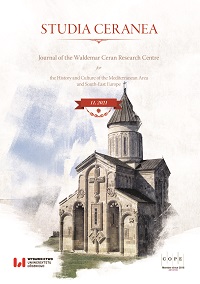The Saint as Food, the Torture as Medicine: Some Aspects of Christopher of Mytilene’s Imagery in his Dodecasyllabic Calendar and its South Slavonic Translations
The Saint as Food, the Torture as Medicine: Some Aspects of Christopher of Mytilene’s Imagery in his Dodecasyllabic Calendar and its South Slavonic Translations
Author(s): Ekaterina DikovaSubject(s): History, Middle Ages, Theology and Religion, History of Religion
Published by: Wydawnictwo Uniwersytetu Łódzkiego
Keywords: medieval Slavonic translations of Byzantine poetry; Christophoros Mitylenaios’ Orthodox iambic calendar; verse memories of martyrs; rhetorical figures
Summary/Abstract: Christopher of Mytilene, a secular poet of the early 11th century, had embarked on a difficult task when creating his dodecasyllabic Christian Calendar, that is two-verse storytelling about saints and, mainly, about the tortures they died of. He accomplished it more than successfully, besides in quite a vivid and spectacular way, by means of various poetic and rhetorical techniques. Food and medicine imagery was just a minute aspect of his mastery, yet a powerful one, acquiring not only artistic and rhetorical, but also mnemonic functions. the poet used such images – just as he used e.g. Biblical allusions – as a way to convey a variety of details in succinct messages; the information thus compressed is unfolded by means of associations in the mind of the perceiver. These associations are related not only to Christianity, but also to many other aspects of the Byzantine cultured life, including certain elements from Antiquity. I will try to reveal this mechanism and to show the attempts of the 14th-century South Slavonic translators to render it as well as their decisions in cases of realia unknown to their audience. For this purpose, I have selected certain Greek verse memories (as given in the editions of Eustratiadis and Cresci & Skomorochova Venturini) from the Verse Synaxarion for the summer half of the year together with their two South-Slavonic correspondences of the 14th century (according to the two respective early manuscripts of the Slavonic Verse Prolog), again only for the months from March to August.
- Issue Year: 2021
- Issue No: 11
- Page Range: 165-176
- Page Count: 12
- Language: English

